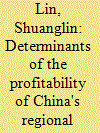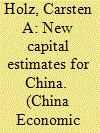| Srl | Item |
| 1 |
ID:
071986


|
|
|
|
|
| Publication |
2006.
|
| Summary/Abstract |
This paper examines the determinants of the profitability of China's local state enterprises. The investment share of non-state enterprises is found to be positively related to the profitability of regional SOEs. Openness measured by exports share in GDP is positively related to regional SOEs' profitability in all cross-sectional and most panel regressions. Debt ratio is negatively related to SOEs' profitability in most cross-sectional and panel regressions. The ratio of unhealthy assets to total assets is negatively related to the profitability in all cross-sectional regressions and is negatively but insignificantly related to the profitability in most panel regressions.
|
|
|
|
|
|
|
|
|
|
|
|
|
|
|
|
| 2 |
ID:
071992


|
|
|
|
|
| Publication |
2006.
|
| Summary/Abstract |
This paper develops a Cournot quantity competition model to examine the effect of export tax rebate policy on export performance. The main conclusions drawn are as follows: (i) when a government raises the export rebate rate, the output of final goods for export by the domestic firm increases, while the output of the foreign competitor decreases; (ii) when a government raises the export rebate rate, the profit of the domestic firm increases, while that of the foreign competitor decreases; and (iii) the optimum export rebate rate is positive and greater than 1, indicating that the domestic government not only refunds fully the custom duties paid by the domestic firm on imported intermediate goods, but also offers export subsidies for its export of final goods.
To corroborate the conclusions drawn based on the theoretical model, empirical analysis was carried out using the statistical data of China from 1985 to 2002. The test results of Spearman rank correlation coefficient show that China's export tax rebate policy has significant positive correlation with its exports, final domestic consumption, and foreign exchange reserve.
|
|
|
|
|
|
|
|
|
|
|
|
|
|
|
|
| 3 |
ID:
071987


|
|
|
|
|
| Publication |
2006.
|
| Summary/Abstract |
Data on physical capital are an indispensable part of economic growth and efficiency studies. In the case of China, economy-wide fixed asset series are usually derived by aggregating gross fixed capital formation (net of depreciation) over time, and sectoral/ownership-specific series by correcting the limited official fixed asset data available. These procedures, to varying degrees, ignore that (i) gross fixed capital formation does not equal investment, (ii) investment does not equal the value of fixed assets newly created through investment, (iii) depreciation is an accounting measure that bears no necessary relation to changes in the production capacity of fixed assets, (iv) official fixed asset data, where available, incorporate significant revaluations in the 1990s, and (v) "net fixed assets" do not measure the contribution of fixed assets to production.
This paper derives economy-wide fixed asset values for 1953-2003, correcting for these shortcomings. It uses both the traditional, cumulative approach and a new, so far unexplored method of combining economy-wide depreciation values and an economy-wide depreciation rate to directly yield economy-wide fixed assets. The derived fixed asset time series are evaluated in a comparison with each other as well as with series in the literature, leading to the recommendation of a specific choice of fixed asset time series.
|
|
|
|
|
|
|
|
|
|
|
|
|
|
|
|
| 4 |
ID:
071988


|
|
|
| 5 |
ID:
071991


|
|
|
|
|
| Publication |
2006.
|
| Summary/Abstract |
We estimate output gaps using three methods for Mainland China on annual data spanning 1982-2003. The estimates are similar and appear to co-move with inflation. Standard Phillips curves, however, do not fit the data well. This may reflect the omission of some important variable(s) such as the effect of price deregulation, trade liberalisation and/or changes in the exchange rate regime. We re-estimate the Phillips curves assuming that there is an unobserved variable that follows an AR(2) process. The modified model fits the data much better and accounts for some of the surprising features of the simple Phillips curve estimates.
|
|
|
|
|
|
|
|
|
|
|
|
|
|
|
|
| 6 |
ID:
071989


|
|
|
| 7 |
ID:
071990


|
|
|
|
|
| Publication |
2006.
|
| Summary/Abstract |
This paper argues that China's exchange rate policy played a critical role in its FDI boom. Devaluation of the Yuan (Renminbi) and the policy of pegging the Yuan to the Dollar both improved China's competitiveness in attracting Foreign Direct Investment. Examining the hypothesis in the context of Japanese FDI for nine Chinese manufacturing sectors from 1981 to 2002, the empirical results show that the real exchange rate between the Yuan and Yen is one of the significant variables determining Japanese direct investment in China. The devaluation of the Yuan substantially enhanced inflows of direct investment from Japan, and the response of FDI to the change of the real exchange rate is elastic.
|
|
|
|
|
|
|
|
|
|
|
|
|
|
|
|